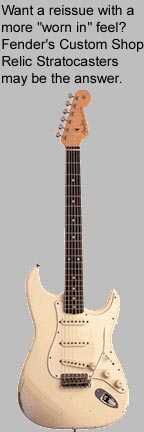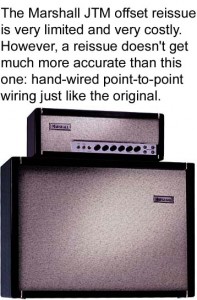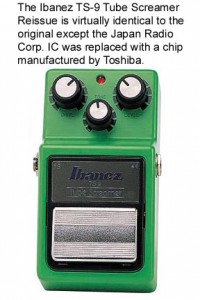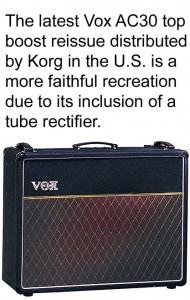During the past few years, there has been a resurgence in the interest of vintage gear of all types, not only guitars and amplifiers, but even effect pedals. In the case of effect pedals, this is a most interesting phenomenon because during the ‘80s, when digital state-of-the-art rack systems were in vogue, effect pedals were basically considered “old junk.” Regardless, with so much interest in the market for vintage tones and gear, it was a no-brainer for companies to seek to fulfill the demand by creating reissues. And of course, like anything else, some of these recreations were built more accurately and better than others.
The decision to buy a vintage piece of gear or a reissue can be difficult and many factors need to be examined. The purpose of this article is to unravel some of the mysteries and point out many of the facts with regards to both versions of gear so that you can make the best purchasing decision. There is no right and wrong and there is no way to say vintage is always “better” compared to a reissue and vice versa. Again, it depends on a number of factors, many of which are personal.
Vintage Dreams…
There is something magical about firing up an older vintage Vox AC30 amp with its NOS EL84s running Class A, or the feel of playing that late 50’s Fender Stratocaster with the smooth lacquered neck and its “checking” body. Beyond the feel and sound of these classic pieces, they also have a history. One can only dream up the possibilities of who played on all this gear throughout the equipment’s long lives. This historical sense is one of the driving forces for vintage gear prices being as high as they are. After all, when you play a reissue, this sense of history just isn’t there no matter how accurate it may be. Deep in your gut, regardless of how good the amp, guitar, or pedal may sound, the feeling of it not being “the real thing” can creep in. That ‘63 reissue Vox just wasn’t there in 1963. It’s just not right…
Another important factor regarding the climbing value of vintage gear has to do with the old adage: “They just don’t build them like they used to.” In many cases today, this is certainly correct. Whereas amplifiers used to be hand-wired with point-to-point wiring techniques, this is just too slow and costly of a process to maintain these days and still retain profitability. Take a look at the circuit photos from the recent Hiwatt Custom 100 DR103 feature and you’ll see an example of a meticulously constructed, all hand-wired, point-to-point amplifier. The same arguments are made for other components too. Tubes, transformers and even capacitors aren’t typically as well made today as they used to be. To players and collectors alike, this is a significant reason why there is often no substitute for vintage gear. Vintage gear harks back to a day when cost wasn’t the primary driving issue for production. Keep in mind though, cost was still an issue even in the “old days” to a certain degree, but modern times are much more fiercely competitive. As a result, cost plays a much larger role today and so doing things such as reducing costs by using lesser-grade components is just one method used to compete today.
Vintage Pro’s and Con’s
There is nothing as satisfying as playing on a good piece of vintage gear. However, there are many issues surrounding the decision to obtain vintage gear that must be addressed. First, please note: because some of the values are so astronomically high, it can be  enticing for a con-artist to make a good forgery and then turn an even greater profit. And it must be said that there have been some great forgeries! I’ve personally seen forgeries of 50’s-era Fender Stratocasters, with attention being made to almost every detail, even down to having the appropriate “pat. pend” bridge saddles.
enticing for a con-artist to make a good forgery and then turn an even greater profit. And it must be said that there have been some great forgeries! I’ve personally seen forgeries of 50’s-era Fender Stratocasters, with attention being made to almost every detail, even down to having the appropriate “pat. pend” bridge saddles.
Another issue surrounding vintage gear is verifying originality. Even if the gear is not a forgery of some kind, for many pieces of gear (amplifiers in particular) maintaining 100% originality is very difficult. In the case of amplifiers, obviously tubes and filter capacitors have a limited life and will need replacement. In addition, other parts may have failed during the amp’s lifetime and needed replacement.
This brings up the question: are you a player or a collector? If you are a collector, then having an amp with 100% all-original components (even if they make the amp sound bad) is worth the added cost you’ll undoubtedly pay. For a player, regular items that are in need of replacement are to be expected.
Collectors have other important issues as well. Verifying 100% originality can be extremely difficult and sometimes even impossible to determine. Not every part in a component is necessarily date coded, and in the case of a company such as Fender, it is not uncommon to have parts used within an amplifier or guitar to have all different years of date codes. Fender worked like any other stock house and would stock up large quantities of parts. If there were extra transformers or guitar bridges around in stock during the transition to the “new” year, these “old” parts would inevitably be used. As a result, date coding from parts can give close estimations of when the final item was made, but it is not an exact science. Also, the question: is a blown original transformer from a ’65 Twin Reverb that is replaced with a properly date coded replacement still make the amp original? Technically, the answer is “no” but then who would know? These are issues that collectors have to grapple with and the reason why attention to every detail (such as solder connections) is often scrupulously made when an item is considered for purchase.
But even as a player, originality to some extent should still be important, especially if you are after a particular sound. What would a Vox or Hiwatt be without their Woden or  Partridge transformers? The bottom line is that these original and very significant parts do affect the sound. When shopping for vintage gear, the best advice is to do your homework and learn as much as you can before laying out the dollars. This holds true whether you want to be a collector or a player.
Partridge transformers? The bottom line is that these original and very significant parts do affect the sound. When shopping for vintage gear, the best advice is to do your homework and learn as much as you can before laying out the dollars. This holds true whether you want to be a collector or a player.
What about the area of customer upgrades such as replacement pickups or custom modifications made to a particular amplifier? In terms of value, in almost all cases, making changes to the original gear will cause it to devalue. There are exceptions of course and this would include any modifications done by a significant known expert in the field or if the modification itself involved an upgrade done by a dealer. A modified Marshall head reworked by Jose Arrendondo (Edward Van Halen’s old tech friend) would potentially have some added value depending on the work done. In the case of Vox AC30’s, the top boost feature was sometimes dealer-added as an upgrade and this doesn’t generally affect value as the top boost AC30’s are much more in demand.
There are other issues surrounding vintage gear of course. To players, even if the vintage gear uses better components and parts as compared to more modern gear, it is likely that more maintenance will be required and the chances for part failure is typically higher. This  is especially true if the gear had been abused or its history is just unknown. In this case, it’s a role of the dice. For amplifiers, one route around this is to purchase an amp that has gone through a restoration. While technically, some of the originality will be lost because various parts will be changed as needed, the end result is an amplifier that will undoubtedly hold up better and more consistently for many more years. This is a good route for the player who wants true vintage gear that is reliable and is also willing to pay the price. In the end, the restored amplifier may actually have a “truer” sound to the original as it is known that parts such as resistors and capacitors will vary from their values a bit as they age. But of course to the collector, the idea of changing parts or putting new vinyl on an amp to restore it is sacrilegious.
is especially true if the gear had been abused or its history is just unknown. In this case, it’s a role of the dice. For amplifiers, one route around this is to purchase an amp that has gone through a restoration. While technically, some of the originality will be lost because various parts will be changed as needed, the end result is an amplifier that will undoubtedly hold up better and more consistently for many more years. This is a good route for the player who wants true vintage gear that is reliable and is also willing to pay the price. In the end, the restored amplifier may actually have a “truer” sound to the original as it is known that parts such as resistors and capacitors will vary from their values a bit as they age. But of course to the collector, the idea of changing parts or putting new vinyl on an amp to restore it is sacrilegious.
Another great path for the player when purchasing an amplifier especially is to consider buying one in need of a restoration, but then focus on an electronics restoration first, with the cosmetic restoration taken care of later if needed. Indeed, many people like the “beat up” or “worn” look from older gear. Even with reissues, this “aging” process is popular as witnessed by Fender’s popular Relic-series Stratocasters. These are basically 50’s era Stratocaster reissues complete with paint checking, cracks, worn finish, and stains!
Reissue Pro’s and Con’s
Sure, a reissue isn’t “the real thing”, but in many cases, reissues can be made extremely close sonically and they also have the cool vintage look and vibe. Careful shopping needs to be done for reissue gear as some reissues aren’t quite reissues at all and may indeed have a different circuit design or use different components all together. In the worst possible case, a reissue may be nothing more than something that just looks like the real thing from the outside and is completely different inside. As with shopping for vintage gear, the rule is to study and learn as much as possible and caveat emptor: let the buyer beware!
In the case of guitars and construction, there were many changes made in manufacturing that does affect tone. Using the Fender Stratocaster as an example, the many thousands of copper windings around the pickups on the early guitars were done on a winding machine that was operated by hand. As a result, pickup output was inconsistent because some pickups had more winds then others and the windings themselves were often a little looser, all contributing to a different sound than the pickups being made today. However, the modern machine-wound pickup’s windings are electronically counted. On reissue Stratocasters, while this may make the pickups to where they are not 100% accurate to the originals, it is probably better overall since the manufacturing is at least more consistent across the line.
Many components used in vintage equipment are also just not available anymore. Different resistors and capacitors, even with the same value, will sound slightly different. In the case of amplifiers, quality of output transformers is certainly a significant issue, but complaints are often made about today’s lack of quality in filter capacitors and especially tubes. Also with regard to amplifier reissues, almost all of them are produced on modern printed circuit boards rather than using the point-to-point wiring of the past. While there is a debate about whether or not this affects the sound, one clear advantage of PCB’s is that again, consistency is maintained during manufacturing.
Another point in favor of reissue gear is that often, improvements are made to the original designs that have a clear benefit. While old Vox AC30’s are known to run very hot and sometimes have literally melted down during use, this was due in part to not having adequate airflow available. On the newest Vox reissues distributed by Korg, larger vents were added on the amp’s top. Another improvement was also made with these new reissues in that they now have a standby switch that allows the amp’s tubes to warm up better and ultimately last longer rather than being immediately jolted with high plate voltages.
While there is also a heated debate amongst tone-freaks regarding whether reissue gear can hold up to its vintage counterparts, there is one question that I must add in defense of reissue gear. When the vintage market has gotten to the point where the prices are so inflated and much of this gear is no longer affordable, what other choice is there? Is it really feasible for most guitarists to lay out $10,000-$50,000 on a vintage Fender or Gibson, or does it make sense to pay $1,000-$2,000 for a reissue? The answer (to me anyway) is clear.
Fortunately, not every piece of vintage gear has such an inflated market value. In fact, sometimes (though rare and by special circumstances only) the originals can be had for  less than the reissues. How is this possible? Examine the Hiwatt Custom 100 DR103s. An original hand-wired amplifier made in the early 70’s will cost somewhere in the range of $700-$900 (as of this writing in February 2001). The reissues currently being produced are going for closer to $2,000 but are said to use very similar (and costly) construction methods as the originals. For a person that wants the vintage vibe and sound, but with the peace of mind of having a warranty, the reissue still may be the way to go, even if it costs a bit more. Having said that though, in the case of early Hiwatts, I find those early amps to be virtually bullet proof!
less than the reissues. How is this possible? Examine the Hiwatt Custom 100 DR103s. An original hand-wired amplifier made in the early 70’s will cost somewhere in the range of $700-$900 (as of this writing in February 2001). The reissues currently being produced are going for closer to $2,000 but are said to use very similar (and costly) construction methods as the originals. For a person that wants the vintage vibe and sound, but with the peace of mind of having a warranty, the reissue still may be the way to go, even if it costs a bit more. Having said that though, in the case of early Hiwatts, I find those early amps to be virtually bullet proof!
Reissue and vintage gear are both passions of mine and I hope to be able to review and examine much more of this for you at LegendaryTones in the future. When we find and review notable and worthy reissues, we’ll certainly make note of that and on the other side, when a reissue isn’t quite up to snuff, we’ll alert you as well. Beyond the studying and reading you should do when shopping for either vintage or reissue equipment, the final decision should always be based on the sounds that you hear. In the end, it is the tone itself that will help inspire you to new musical heights. So with that, enjoy your gear, regardless of what path you chose and feel good knowing you’ve made the right choice for you.